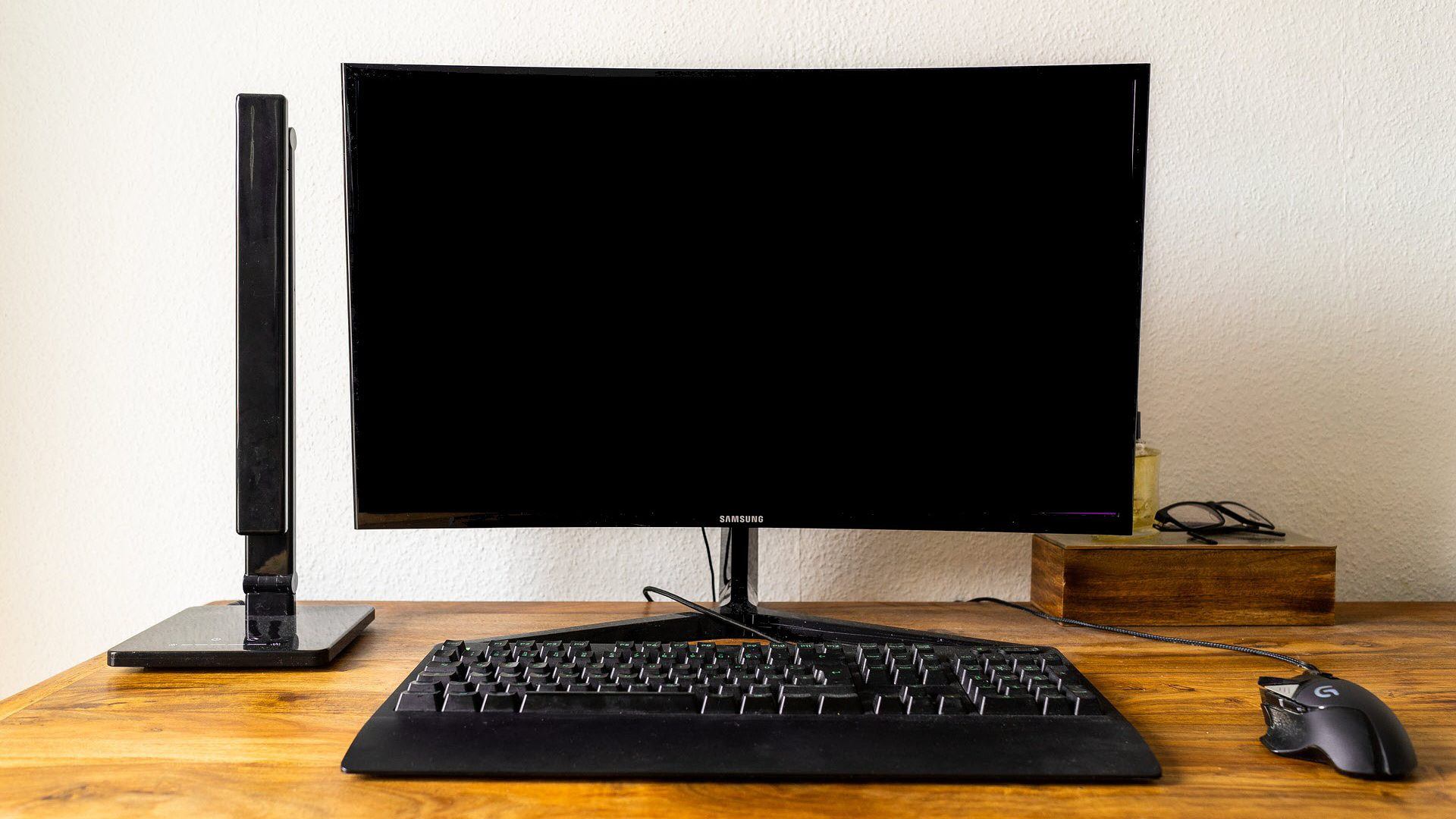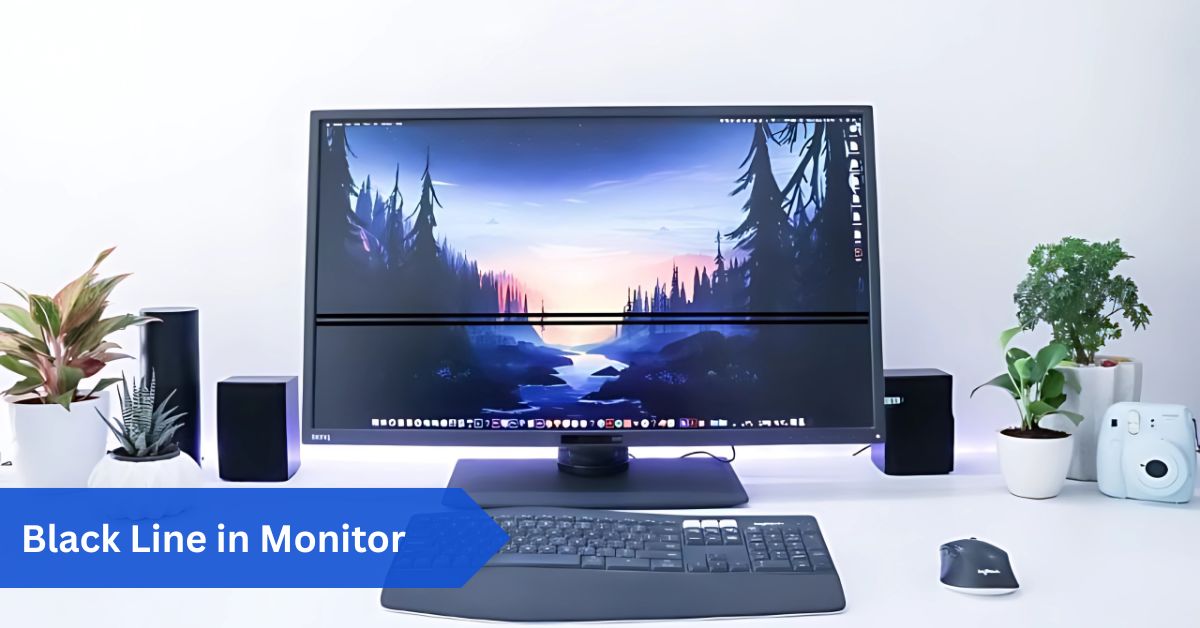Introduction:
Monitors are our windows to the digital world, expected to display sharp and seamless visuals. Yet sometimes a black line appears across the screen, disrupting your work or entertainment. While it may seem like a serious fault, such lines often result from minor software or hardware issues rather than a broken monitor.
Seeing a black line on your screen can be alarming, but it’s often caused by minor issues like loose cables or overheating. Restart your device, check connections, and update drivers to fix it. If the line persists, it may indicate a damaged display or GPU, requiring professional repair. Regular maintenance helps prevent such issues.
This guide explains what causes black lines on monitors, how to fix them, and how to prevent them. Whether you’re using a desktop, laptop, or gaming display, you’ll find simple troubleshooting steps and long-term solutions to restore a clear and uninterrupted screen.
In This Article, we discuss “Black Line in Monitor.”
What Does a Black Line on a Monitor Mean?

A black line in monitor refers to a horizontal or vertical dark strip that appears across your display. Sometimes it looks like a thin hairline, while other times it can be a thick band covering a large portion of the screen. Depending on the root cause, these lines may be:
- Static (always present in the same spot).
- Intermittent (appearing only sometimes, like after long use).
- Dynamic (moving or flashing in response to screen presses or laptop lid adjustments).
These lines can occur due to hardware malfunctions, such as a damaged screen panel, a loose display cable, a faulty GPU, or physical impact. But they can also appear due to software-related issues like outdated drivers, incorrect display settings, or even overheating.
Common Causes of Black Lines on Monitors:
Let’s break down the most frequent reasons behind black lines. Understanding these causes will make troubleshooting easier.
1. Physical Damage:
The most frequent offender is bodily harm. Internal display layers can be damaged by dropping your laptop, knocking your monitor, or applying pressure to the screen. When rows or columns of pixels stop working, cracks or pressure points frequently appear as black lines.
2. Loose or Damaged Cables:
Monitors rely on internal and external cables to transmit display data. If the display cable (LVDS/eDP in laptops or HDMI/DisplayPort in desktops) is loose or damaged, the signals don’t transfer properly, resulting in lines across the screen.
3. Graphics Card (GPU) Issues:
Image rendering is the responsibility of the GPU. Display abnormalities, such as black lines, may be caused by a malfunctioning graphics card, bad VRAM, or incorrect motherboard seating. The GPU is most likely at blame if you see the lines on both your laptop’s screen and an external monitor.
4. Outdated or Corrupt Graphics Drivers:
Software plays a big role in how your monitor communicates with the hardware. Outdated, missing, or corrupt drivers can distort visuals and trigger black lines. This is often an overlooked cause but relatively easy to fix.
5. Overheating:
When laptops or desktops overheat, it affects GPU and display performance. Overheating can lead to temporary flickering black lines. If you notice lines appearing after prolonged use, heat may be the reason.
6. Dead or Stuck Pixels:
A cluster of dead or stuck pixels often appears as a thin black line. Dead pixels are permanently off, while stuck pixels might display incorrect colors. Both issues can create the illusion of a black line.
7. Incorrect Display Settings:
Running your monitor at the wrong resolution, refresh rate, or scaling setting can cause graphical inconsistencies. Incorrect contrast or brightness settings can also exaggerate the appearance of lines.
How to Diagnose Black Line Issues on Your Monitor:

Finding the source of the issue is crucial before attempting to solve it. Here are a few easy diagnostic procedures:
- Restart your computer.
A restart resets temporary glitches. If the line disappears, the issue was likely software-related. - Check for physical damage.
Hold your laptop or monitor at different angles and look carefully for cracks or pressure marks. - Test with an external monitor.
- If the line shows up on both screens, → likely GPU or driver issue.
- If it only shows on the original screen → panel, or cable issue.
- If the line shows up on both screens, → likely GPU or driver issue.
- Press around the screen edges.
If you notice the line flickering or changing, it could be due to a loose display cable. - Check your graphics drivers.
Open Device Manager (Windows) or System Report (Mac) and confirm your drivers are updated.
Step-by-Step Fixes for Black Line Issues:
Now let’s explore practical solutions, starting with the easiest and moving toward more advanced fixes.
1. Restart Your Device:
It may sound simple, but many black line issues vanish after a restart because temporary memory glitches or driver conflicts get resolved.
2. Check for Cable and Port Issues:
- Unplug and replug your monitor cables (HDMI, DisplayPort, VGA, USB-C).
- Inspect cables for bends, cuts, or damage.
- Try a different port or cable.
- For laptops, this often means checking the internal ribbon cable that connects the display to the motherboard (though opening a laptop requires technical skill).
3. Update Graphics Drivers:
Outdated graphics drivers are the ones that cause the black lines on your screen frequently. To update:
On Windows:
- Right-click the Start menu and select Device Manager.
- In Device Manager, expand the Display Adapters section, right-click your graphics card, and choose Update driver.
- Choose Search automatically for drivers to allow Windows to look for the most recent version of the drivers.
On Mac:
- Run a full system update via System Settings > General > Software Update.
4. Check Display Settings:
- Right-click on the desktop → Display settings.
- Ensure the resolution matches your monitor’s native resolution.
- Adjust the refresh rate under Advanced display settings.
- Reset to default if unsure.
5. Test for Pixel Issues:
You can use pixel-fixing software such as:
- JScreenFix (online tool for stuck/dead pixels).
- Online Monitor Test to detect stuck pixel rows.
- Pixel cycling tools that rapidly change colors to revive stuck pixels.
6. Monitor Calibration:
Sometimes black lines look worse if the brightness, contrast, or scaling is off. Open your monitor’s built-in menu and try resetting it to the factory default settings.
7. Check GPU Health:
If black lines show up on several screens, your GPU might be broken.
- Reseat the GPU in its slot (desktop PCs).
- Perform a GPU stress test with FurMark or similar tools.
- If the issue worsens under load, you may need professional GPU repair or replacement.
8. Prevent Overheating:
- Clean laptop/PC vents.
- Use cooling pads or external fans.
- Avoid blocking airflow.
Overheating can cause temporary black lines that vanish when the system cools.
9. Professional Repair or Replacement:
If none of the above works, you may need professional help. Screen replacement is common for laptops, while desktop monitors are often cheaper to replace than to repair.
Preventing Black Lines on Monitors:

Prevention is always better than repair. Here are some tips to reduce the chances of black lines appearing in the future:
- Handle screens gently. Avoid pressing, tapping, or leaning on them.
- Keep cables secure. Replace worn-out or bent cables immediately.
- Regularly update drivers. Prevents software conflicts.
- Maintain cooling. Don’t let your laptop or PC overheat.
- Use surge protectors. Power fluctuations can damage monitors.
- Clean screens properly. Always use a microfiber cloth—never abrasive cleaners.
Real-World Scenarios and Solutions:
Let’s look at a couple of situations to help make this more accessible.
- Scenario 1: A student’s laptop develops a vertical black line after being dropped.
Solution: Physical damage likely caused a cracked display. A screen replacement is required. - Scenario 2: A gamer notices horizontal flickering lines during gameplay.
Solution: Overheating GPU or outdated drivers. Cleaning fans and updating drivers fixes the issue. - Scenario 3: An office worker connects their laptop to an external monitor, but both show black lines.
Solution: The GPU is failing, and professional repair is necessary.
Conclusion:
A black line in your monitor can be frustrating, but it’s not always a death sentence for your screen. From simple fixes like updating drivers or reseating cables to more serious solutions like screen replacement, there are multiple ways to tackle this issue.
The key is to diagnose the cause—whether it’s hardware, software, or external damage—and apply the right fix. With preventive care and timely updates, you can extend the life of your monitor and avoid future disruptions.
Remember: do not be afraid to seek professional assistance if the problem continues after troubleshooting. Sometimes, a quick fix is all that is required to have a screen that works perfectly.
FAQs:
1. Why does my monitor have a black line?
It could be due to physical damage, faulty cables, GPU issues, overheating, or software glitches. A quick check of your cables and drivers can often narrow down the cause.
2. Can I fix black lines without replacing the screen?
Yes, if they’re caused by outdated drivers, loose connectors, or incorrect display settings. Replacement is only needed if there’s physical damage. Always try the simple fixes first before considering costly repairs.
3. Are black lines permanent?
Not always. Some are temporary glitches (like overheating or driver bugs), while others (like dead pixels or cracks) are permanent until repaired. The best way to know is to test different fixes before assuming the worst.
4. How much does it cost to repair?
Screen replacement can cost $100–$300 for laptops, while replacing a desktop monitor may be cheaper than repairing it. Prices vary depending on your device model and local repair shop rates.
5. Can overheating cause a black line in monitor?
Yes. When GPUs or screens overheat, temporary flickering black lines may appear. Make sure your device has proper cooling and isn’t blocked by dust buildup.
6. What if the line moves when I press the screen?
This usually indicates a loose or damaged internal display cable. Avoid pressing too hard, as it can worsen the damage.
7. Should I attempt to fix the issue myself?
Easy fixes include checking cables and updating drivers. For internal screen or cable repairs, the safest option is to seek professional help. DIY attempts on internal parts can void warranties or cause more harm.
8. Do warranties cover black line issues?
If caused by manufacturing defects, yes. If due to physical damage, warranties usually don’t apply. Always check your warranty terms before paying out of pocket.
9. Are black lines related to screen burn-in?
Not exactly. Burn-in causes ghost images, while black lines usually come from pixel, cable, or GPU issues. Think of burn-in as a “faded shadow,” while black lines are more like missing or broken areas.
10. Can an external monitor solve the problem permanently?
No—it only bypasses the issue if the internal screen is faulty. The underlying problem still remains. It’s a good temporary solution, especially if you need your device for work.
Read More:
Shadow on Computer Monitor: Guide to Ghosting, Double Images, and Fuzzy Text
Monitor Scaling: Everything You Need to Know
Service Brake Pad Monitor: The Ultimate Guide
Can’t Detect Second Monitor? 15 Proven Fixes For You
Windows Not Detecting Second Monitor: A Complete Guide
